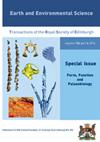Stratigraphic architecture of the Cenozoic Dugong Supersequence: implications for the late post-breakup development of the Eucla Basin, southern Australian continental margin
IF 1.2
4区 地球科学
Q4 GEOSCIENCES, MULTIDISCIPLINARY
Earth and Environmental Science Transactions of the Royal Society of Edinburgh
Pub Date : 2022-09-01
DOI:10.1017/S1755691022000123
引用次数: 1
Abstract
ABSTRACT This study presents an appraisal of the Middle Eocene–Quaternary Dugong Supersequence of the Eucla Basin, offshore southern Australia. It combines details of the rock record with seismic-stratigraphical information, and the resulting stratigraphic framework provides constraints on the nature of the late post-breakup development of the southern Australian continental margin. It is well established that the onshore-to-mid-shelf succession comprises a predominantly aggrading-to-prograding unconformity-bounded succession of carbonate platform deposits; however, our analysis of the outer shelf–upper slope section challenges the widely held view that this shelf-margin wedge represents a distally steepened prograding carbonate ramp primarily modulated by global eustasy. Instead, our results show that the Middle Eocene–Quaternary succession is punctuated by a series of unconformities that reflect a persistent tectonic instability and differential vertical movements throughout the late post-breakup period, the genesis of which is most closely related to tectonic events. Moreover, the upper slope clinoform succession was constructed and shaped predominantly by alongslope processes, and four different contourite drift types are recognised based on their seismic-stratigraphic expression: elongate mounded drift (Quaternary); infill drift (Pliocene); plastered drift (Oligocene); and separated drift (Middle–Upper Eocene). The Quaternary drift – herein termed the ‘Eyre Terrace Drift’ – is a spectacular basin-scale deposit, over 500 m thick and traced for up to 200 km along the upper slope Eyre Terrace. Upslope-migrating sediment waves are associated with this drift. Key sedimentary attributes consistent with a contourite origin include fine-grained sediment, multi-scale gradational bed contacts and pervasive bioturbation. There is also evidence of episodic downslope mass-movement processes ranging from the large-scale Late Neogene Slide, which extends downslope for 15–20 km, to sporadic slumped beds and turbidites recovered in boreholes. The interaction of alongslope and downslope processes indicates a more dynamic sedimentary setting than previously assumed along the outer margin of the Eucla Basin.新生代Dugong Supersequence的地层结构:对澳大利亚南部大陆边缘Eucla盆地后期破裂后发展的启示
摘要本研究对澳大利亚南部近海尤卡拉盆地始新世中期-第四纪儒艮超层序进行了评价。它将岩石记录的细节与地震地层信息相结合,由此产生的地层格架为澳大利亚南部大陆边缘后期破裂后发展的性质提供了限制。陆上-中陆架层序包括碳酸盐岩平台沉积物的主要加积-进积不整合边界层序;然而,我们对外陆架-上斜坡剖面的分析挑战了人们普遍认为的观点,即该陆架边缘楔体代表了一个主要受全球海平面上升调节的远陡进积碳酸盐岩斜坡。相反,我们的研究结果表明,始新世中期-第四纪序列被一系列不整合打断,这些不整合反映了整个后破裂后期持续的构造不稳定和差异垂直运动,其成因与构造事件最为密切。此外,上坡斜坡序列主要由顺坡过程构造和形成,根据其地震地层表达,可识别出四种不同的等深岩漂移类型:细长丘状漂移(第四纪);填充漂移(上新世);膏状漂移(渐新世);和分离漂移(中-上始新世)。第四纪漂移——这里称为“Eyre Terrace漂移”——是一个壮观的盆地级矿床,厚度超过500米,沿Eyre阶地上坡延伸200公里。上坡迁移的沉积波与这种漂移有关。与等深岩成因一致的主要沉积属性包括细粒沉积物、多尺度渐变床接触和普遍的生物扰动。还有证据表明,从大规模的晚第三纪滑坡(向下延伸15-20公里)到钻孔中发现的零星坍塌床和浊积岩,都存在幕式的下坡岩体运动过程。顺坡和下坡过程的相互作用表明,沿尤卡拉盆地外缘的沉积环境比以前假设的更具动态性。
本文章由计算机程序翻译,如有差异,请以英文原文为准。
求助全文
约1分钟内获得全文
求助全文
来源期刊
CiteScore
2.00
自引率
0.00%
发文量
21
期刊介绍:
Earth and Environmental Science Transactions (formerly Transactions of the Royal Society of Edinburgh: Earth Sciences) is a general earth sciences journal publishing a comprehensive selection of substantial peer-reviewed research papers, reviews and short communications of international standard across the broad spectrum of the Earth and its surface environments. The journal prides itself on the quality of its graphics and photographic reproduction. The Editors are keen to encourage interdisciplinary papers and Transactions also publishes occasional special symposia and invited volumes of specific interest.
We are currently in the process of digitising the archive of RSE Publications, and the archive of the Transactions, dating back to 1788, will be available from the back issues link on this site.

 求助内容:
求助内容: 应助结果提醒方式:
应助结果提醒方式:


